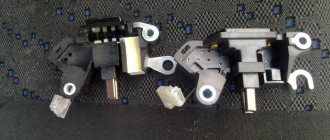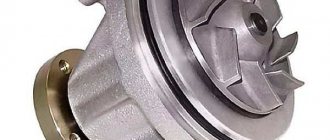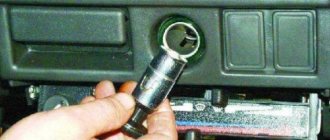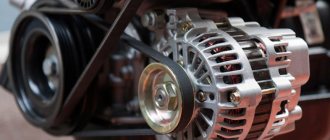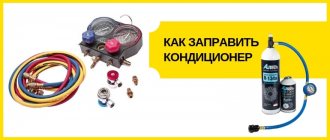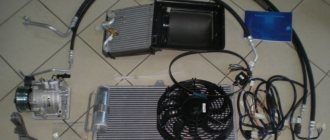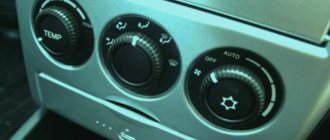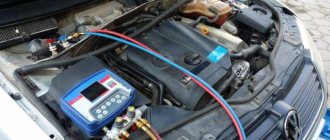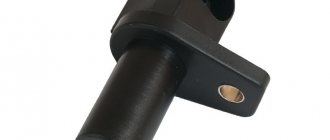In modern cars, the microclimate in the cabin is provided by three systems - ventilation, heating and air conditioning. And the most structurally complex of them is the air conditioner, whose task is to cool the air in the cabin in the summer. Despite this, the air conditioning system is quite common and is installed on many cars, even in the budget segment.
The operating principle of a car air conditioner is based on the property of certain substances to absorb and release heat when their state of aggregation changes. The same principle is used in household refrigerators and stationary air conditioners. Therefore, all of the listed devices are structurally very similar and consist of the same components. But a car air conditioner is distinguished by its more compact size and the type of drive of one of the main components - the compressor.
How does the air conditioning system work in a car?
The compressor is driven by a belt from the crankshaft.
The compressor compresses the refrigerant entering it in a gaseous state. When refrigerant is compressed, a lot of heat is released. The refrigerant, compressed and heated to approximately 100°, enters the radiator-condenser . Passing through the condenser, the refrigerant is cooled to approximately 45° and changes from a gaseous state to a liquid state. Those. condenses. The receiver-dryer located on the condenser accumulates liquid refrigerant. In its flask there is a desiccant substance that absorbs moisture after assembling and vacuuming the entire system. The same flask may also contain a filter that retains compressor wear products.
On our YouTube channel you can watch a video review about car air conditioners.
You can select and buy an air conditioning compressor for your car in our used spare parts catalog.
From the condenser, liquid refrigerant is directed at a fairly high pressure of about 17 bar to the evaporator. On its way to the evaporator, it passes through an expansion valve or expansion valve . This valve has 2 functions: to reduce the refrigerant pressure and to regulate its supply to the evaporator. Passing through the expansion valve, the refrigerant pressure drops to 4 bar. In this case, the refrigerant evaporates and absorbs heat from the environment, cooling to 10°. At this temperature it enters the evaporator.
Instead of a thermal valve, an expansion throttling insert can be used, which continuously meters the supply of freon to the evaporator. In this case, liquid refrigerant collects in the evaporator. In this condition, it should not get into the compressor, which will cause water hammer. Therefore, on the way to the compressor, the freon enters a separate battery, in which it is simply evaporated.
The evaporator belongs to the interior ventilation system. The fan directs the air entering the cabin to it. In the evaporator, the refrigerant evaporates, removing heat from the environment. Those. it cools and dries the air passing through the evaporator. The refrigerant evaporated in the evaporator is again sent to the compressor.
You can select and buy an air conditioning evaporator for your car in our catalog of used spare parts.
The accumulator-drier is used in an air conditioning system with a throttling insert instead of a thermal valve.
In general, during operation of the entire air conditioning system, the evaporator temperature is maintained at a certain level, about 10°. Regulation is carried out in the same expansion valve, but in a different circuit with a thermostat. It goes like this. The more the refrigerant heats up in the evaporator, the higher its pressure will be. This pressure pushes on the thermostat membrane. Thus, the warmer the refrigerant leaving the evaporator, the more it presses on the membrane, which through the rod opens the ball valve more strongly, which releases more refrigerant to the evaporator.
Purpose and functions
A car air conditioner is designed to cool the air during the hot season. The main task of the device is to create a comfortable microclimate in the vehicle interior and make the trip comfortable for the driver. The air conditioner also cleans and dehumidifies the air entering the car and ensures its circulation.
Air conditioning in your car will ensure a comfortable ride even on the hottest days
Using an air conditioner allows you to clean the air from dust and harmful substances. The device provides an antibacterial effect and protection against unpleasant odors.
Types of air conditioning compressor in cars
There are 3 types of air conditioning compressors used on cars. The most common type: piston. There are options with variable and fixed displacement. Accordingly, the compressor design can have from 5 to 7 pistons or 10 pistons. Piston compressors can have either variable or permanent drive.
Rotary type compressors are less common. The rotor can have blades or be a movable spiral immersed in the same fixed spiral. Both types of rotary compressors are common on Japanese cars.
Since 2012, air conditioning compressors with an electric drive and a spiral rotor have been increasingly used.
How does an air conditioning compressor work?
The only function of the air conditioning compressor is to take the refrigerant evaporated in the evaporator, compress it to a higher pressure and send it to the condenser to cool and turn into a liquid state. The entire air conditioning system can be self-regulating or controlled by external commands. In both cases a corresponding control valve is used.
When is refueling needed?
The refrigerant tends to gradually evaporate, so the air conditioner must be recharged periodically. New cars require refueling on average once every 2-3 years. Vehicles older than 5-6 years are refueled annually (or once every two years).
If the air conditioning system fails, you must first ensure its serviceability and tightness and only then refill the gas.
It is recommended to entrust charging the air conditioner with refrigerant to car service specialists who have the necessary equipment to successfully complete the work.
How does the displacement of a compressor change?
When high compressor performance is required, gaseous refrigerant under high pressure enters its inlet. As we know, his blood pressure increases because... too much refrigerant has evaporated in the evaporator.
This pressure pushes on the compressor pistons. In this case, the control valve relieves gas pressure from the crankcase into the suction line. In this case, the suction pressure above the pistons will be higher than the pressure that “props” them out of the crankcase. Consequently, this pressure will force the pistons to increase their stroke. Thus, the working volume of the compressor cylinders also increases.
When less refrigerant evaporates in the evaporator, the suction line pressure will be lower. To reduce the working volume of the cylinders, part of the gas (refrigerant) compressed by the pistons is directed into the crankcase. This pressure puts pressure on the pistons from behind, causing them to reduce their stroke.
Thus, the change in the working volume of the compressor occurs due to the balance of forces on the pistons and below them - in the crankcase.
Compressor oil
In addition to the refrigerant, the air conditioning system contains a special oil. It lubricates all friction pairs. Oil circulates throughout the entire circuit and is also present in the compressor crankcase. Depending on the type of compressor and the refrigerant used, different types of oils are used, which absolutely cannot be mixed with each other, because Paraffin may form and clog the system.
Compressor oil is completely transparent and almost colorless. It may have a bright green color if it contains dye.
Malfunctions and breakdowns of the compressor and air conditioning system
The most common failure of an air conditioning system is refrigerant leaking through leaking seals or cracks. If there is a lack of freon, the performance of the air conditioning system decreases. When the freon level is very low, the system can completely turn off the compressor to avoid its breakdown. A low level of freon is determined when refilling it by the quantity and pressure drops in the system. Compressor oil leaks indicate a large hole. Although in most cases it is necessary to add a special dye to the system, visible in ultraviolet light.
The enemies of the cylinder-piston group or compressor rotor are increased friction due to lack of oil or increased refrigerant pressure. Also, increased pressure leads to overheating of the compressor and the oil, which becomes too liquid. These factors lead to friction pairs rubbing against each other, and the entire system becomes clogged with aluminum powder.
Why does refrigerant overpressure occur? The first reason is factors that prevent normal condensation. This is a dirty condenser or a non-working fan on it. Also, excess pressure can be caused by an excess amount of refrigerant charged.
If metal shavings get into the air conditioning system, it must be washed out and even the evaporator and condenser must be replaced. Otherwise, the chips will very quickly finish off the newly installed compressor.
Failures of other mechanical and electronic components such as expansion valve and control valve are quite rare. They manifest themselves in the fact that the air conditioner does not cool as it should, but there is enough freon in the system and there are no leaks.
What is refrigerant?
A refrigerant is a substance that can easily change from one state of aggregation to another. Circulating along the system circuit, it ensures proper operation of the air conditioner.
Some time ago, chlorine-containing freon R12 was used in air conditioners. However, this substance had a negative effect on the ozone layer of the atmosphere. Therefore, all cars produced after 1993 began to use fluorine-containing R134a. These two types of substances are incompatible.
There is also a new generation - R1234yf. This is the most environmentally friendly refrigerant, which, however, is flammable. Until 2022, car air conditioners were extremely rarely adapted to the new refrigerant. However, today many countries have begun to gradually switch to R1234yf.
R134a is the most common refrigerant in modern cars
Constant drive clutch
Air conditioning piston compressors are often permanently driven. Those. their shaft constantly rotates when the engine is running, there is no electromagnet in the pulley, and no wires are connected to the clutch.
Permanent drive clutches can be plastic or metal and can be belt driven or shaft driven. Inside such a coupling there are always simple rubber dampers. The dampers are located between the pulley and the drive plate, which is mounted directly on the compressor shaft. The drive plate is also called a "stall" or "safety" plate.
This means that if the compressor shaft is jammed or there is excess pressure in its housing, the drive plate is literally destroyed: a break occurs in a special safety element or section of the plate. This breaks the connection between the shaft and the compressor pulley. Also, breakage of the safety plate occurs due to runout of the drive belt, a malfunction of the tension roller, or jamming of the generator overrunning clutch.
Other drive plate failures are also possible. A permanent drive clutch that has served for a long time may begin to knock while the engine is running. The knocking occurs due to the destruction of rubber dampers and the appearance of play. Those. The drive plate connecting pins will click against the grooves in the pulley. After some time, ignoring the knock leads to all the pins being cut off, i.e. again, the connection between the pulley and the compressor shaft is destroyed.
Some cars use permanent drive compressors, the coupling of which does not have an elastic damper, but uses a shock-absorbing weight. Such couplings are destroyed due to problems with the tension of the drive belt.
The permanent drive clutch rotates on a bearing mounted on the neck of the front cover of the air conditioner. If there is play in the bearing, in most cases it can be replaced with a new one. But at the same time, the seating plane on the neck should not be worn out.
When installing a new drive plate on many VAG compressors, it is extremely important to remember to install a shim on the compressor shaft. Without it, when screwing, the plate will simply break as intended by the manufacturer in the event of a jammed compressor shaft.
Car air conditioner maintenance
As a rule, to increase the service life of the air conditioner in a car, it is necessary to periodically service the system, as well as promptly respond to failures and malfunctions.
- Maintenance comes down to flushing the condenser, as well as maintaining the tightness of the entire system.
For example, if the pipes of the system's main lines vibrate or it is noticeable that any element can rub them, it is necessary to secure such sections of the main line or protect them from mechanical damage. Otherwise, cracks or leaks may occur at the connections. It is also important to understand that during operation, freon inevitably “leave” from the system. This means that it is periodically necessary to diagnose and refill the car air conditioner. In this case, the system must be charged correctly, using a special installation. The installation performs a complete pumping out of freon, then adds the required amount of oil and performs a full refueling. - Another problem may be the appearance of an unpleasant odor when the air conditioner is turned on in the car. It should be taken into account that bacteria and fungi can accumulate on the evaporator (humid environment), which causes such an odor. To solve the problem, it is necessary to clean the evaporator using special car air conditioning cleaners.
Electromagnetic clutch
The second option for driving the air conditioning compressor is using an electromagnetic clutch. In this case, the pulley and compressor shaft are not in permanent connection. The pulley is mounted on a bearing mounted on the neck of the front cover of the compressor housing and rotates freely from the attachment belt. A drive plate with a rubber or spring damper is connected to the compressor shaft. There is an electromagnetic coil inside the pulley. When voltage is applied to it, a magnetic field is created that attracts and presses the drive plate to the pulley. In this case, the pulley and compressor shaft rotate together as one unit. When the voltage is removed from the coil, the drive plate disengages from the pulley: a gap is created between them.
Most often, the electromagnetic clutch begins to slip. Namely, the drive plate slips relative to the pulley. Not in all cases, slippage begins due to wear of the mating surfaces of the coupling. Usually, excessive refrigerant pressure appears in the compressor itself, which puts a lot of stress on the clutch and causes it to slip.
Well, then the destruction process goes very quickly: the rubbing drive plate and pulley destroy the mating surfaces, and a lot of heat is released, which bakes the rubber components and can burn the electromagnetic coil.
The clutch is protected from overheating as a result of slipping by a thermal fuse, which opens the power supply circuit of the electromagnet.
Some types of couplings have a rubber drive plate damper, which is destroyed if the compressor shaft rotates with increased force or is jammed.
Play in the entire coupling occurs due to wear of the bearing and journal of the front cover of the compressor housing. If the journal is worn out, then even after installing a new bearing the pulley will rotate with play and runout.
Clutch bearing
If the clutch bearing falls apart, the clutch rattles and plays during engine operation. If you neglect these symptoms and do not rush to service, the bearing may rotate and lift up the neck of the compressor front cover. In this case, even after installing a new bearing or coupling, the pulley play will not go away. For a complete repair, you will have to buy either a new front cover or a used compressor. There are also options with neck restoration.
Also, a loose clutch quickly wears out the drive belt and its tension roller.
